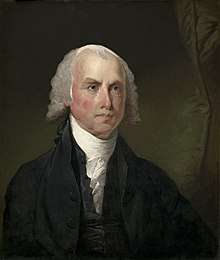Federalist No. 39
Federalist No. 39, titled "The conformity of the Plan to Republican Principles", is an essay by James Madison, the thirty-ninth of The Federalist Papers, published on January 16, 1788.[1] Madison defines a republican form of government, and he also considers whether the nation is federal or national: a confederacy, or consolidation of states.
 James Madison, author of Federalist No. 39 | |
| Author | James Madison |
|---|---|
| Language | English |
| Series | The Federalist |
| Publisher | The Independent Journal |
Publication date | January 16, 1788 |
| Media type | Newspaper |
| Preceded by | Federalist No. 38 |
| Followed by | Federalist No. 40 |
This essay is one of many to urge ratification of the U.S. Constitution. James Madison, along with Alexander Hamilton and John Jay, sent these essays to try to sway the remaining nine states to preserve the Federal form of government, with a National government interest.[2]
Background
Madison, as written in Federalist No. 10, had decided that factions cannot be controlled by pure democracy since:
A common passion or interest will, in almost every case, be felt by a majority of the whole; a communication and concert result from the form of government itself; and there is nothing to check the inducements to sacrifice the weaker party or an obnoxious individual.[3]
Madison then theorizes the use of a Republic, and the first form of a Republic must be evaluated. The Roman Republic was a republic, but it was heavily monopolized at the top—almost aristocratic, in a sense, as they only cared about the rich. The poor were treated as outcasts, and not members of society—they were also viewed as politically immature and couldn't even talk at public meetings. This was not viewed the same way in the Madisonian Republic: there, everyone is treated equally and has a say.[4]
Madison's Argument
Madison defines what republic means and states three rules which must apply to be considered a republic:
- What is the foundation of its establishment? Only the people of the nation and no one else would make the decision of who rules the government.
- What are the sources of its power? The person who is chosen by the people shouldn't break any rules nor abuse the power that they have.
- Who has the authority to make future changes? When someone is chosen to rule the country, they should only be in that position for a certain amount of time unless the people of the nation feel that it's best to impeach them.[5]
This corresponds to the Madisonian republic, which means the system of government where the citizens of the state elect representatives to make decisions for them using three powerful branches: the executive, the judicial, and the legislative.
From early in the Constitutional Convention, Madison held the position that the national government should be federal, because if it was more extensive in relation to the states that would increase the, "probability of duration, happiness and good order".[6] It was not initially clear how the new government would interact with the states, and Madison was in favor of a federal form, a "a political system in which at least two territorial levels of government share sovereign constitutional authority over their respective division and joint share of law-making powers; differently put, neither the federal government nor the relevant federative entities may unilaterally alter one another's powers without a process of constitutional amendment in which both levels of government participate.".[7] Other alternatives included a confederacy as under the Articles of Confederation or a more strictly national government.[8]
References
- "The Federalist Number 39 (16 January 1788)". archives.gov. Retrieved July 30, 2020.
- "Federalist Papers".
- "The Federalist Papers: No.10". The Avalon Project.
- Mouritsen, Henrik (2001). Plebs and Politics in the Late Roman Republic. Cambridge. pp. 2–7.
- "The Federalist Papers No. 39".
- "Contemporary Visions Of The Early Federalist Ideology Of James Madison: An Analysis Of The United States Supreme Court's Treatment Of The Federalist No. 39". Washington University Journal of Law & Policy (2004): 257-287. 16.
- O'Leary, Brendan. "Federalist Papers". Encyclopedia Princetoniensis: The Princeton Encyclopedia of Self-Determination.
- Diamond, Martin. "The Federalist on Federalism". The Yale Law Journal. 86.6.
External links
| Wikisource has original text related to this article: |